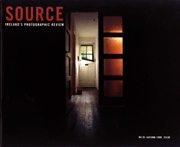Dead Flowers
'Life without Life' by Nigel Rolfe was at the Green on Red Gallery in July 1999
Review by Richard West
Issue 20 Autumn 1999
View Contents ▸
Nigel Rolfe was once a performance artist who incorporated projections into his work. He then exhibited photographs which, though autonomous, seemed to record his performances. He is now almost entirely absent from his photographs. In 1988 an audience for Belgrano would have seen a projection of the 'Mary Rose' and the artist smeared in red paste in an overflowing bath. In 1999 we see 162 slides projected in a dark room. Despite the change there is a consistency about the way the artist engages his viewers and asks them to understand his imagery.
Watching Belgrano the audience would not have needed to be especially imaginative to see the bath as either a ship or an ocean. Anyone that has stepped in a theatre would be familiar with this basic creative involvement in dramatic make-believe and symbolism. By the same token the dead flowers in the latest show Life without Life might represent 'organised injustices worldwide', as the press release has it. Similarly, just as Belgrano must have been a dramatic and engaging experience with a background soundtrack, Life without Life makes 'spectacular use of the gallery space' and 'the mood is enhanced and sharpened by the original music that plays throughout'. But then a photograph is not a performance and when it comes to theatre there is no substitute for the live event. Nigel Rolfe Life without Life
Nigel Rolfe Life without Life
The gallery space was dark and the projections, onto a wall about 4m by 8m, changed gradually. The images were slightly tinted, black and white photographs, mostly of dead flowers. There was a suggestion of sequence with successive images moving to different parts of the same flower and different species being projected in turn. There were photographs of poppies and lilies, familiar from a previous work Two Drums. There were also images of the artist's hand grasping stems like many of the photographs that made up Resonator in 1992. The images which included the artist were in the minority and the suggestion of gesture or a symbolic act of grasping went against the general tone of rarefied beauty. The music, composed by the artist, was somewhere between religious minimalism, in the manner of Arvo Part and a wildlife documentary (with occasional military drums). A constant ambient sound, it implied a corresponding response to the work somewhere between the awe inspired by a cathedral and wonderment at a natural history museum. Like bad film music, it was only likely to be intrusive if the viewer was not taken in. It also suggested that, as with 360° cinemas or night-club visuals, the exhibition was high on effect but had little to say. This was unfortunate as the installation was certainly impressive enough and the images did not require additional 'mood enhancement'. Nigel Rolfe Life without Life
Nigel Rolfe Life without Life
Photographs - ubiquitous, endlessly reproducible and still - do not have the dramatic potency of a performer enacting a symbolic representation in front of an audience. It is the contrast between these forms that describes what is problematic about Life without Life. With the directness of his approach Rolfe has succeeded in challenging the viewer to discover the resonance of the objects he has chosen to photograph. But can the artist really expect his audience to use their imagination when they look at a photograph? Nigel Rolfe Life without Life
Nigel Rolfe Life without Life
Photographs already have too much untrustworthy, ambiguous reality in them to interpret; why complicate matters by asking people to imagine further associations. Just as obsessive literalness and realism would miss the point in a theatre, does photography lend itself to his allusive, suggestive methodology? This is the object Rolfe has set himself, to produce images that carry the symbolic charge of his performances, enabling him to address moral and political themes. Nigel Rolfe Life without Life
Nigel Rolfe Life without Life
In choosing dead flowers, the artist has selected imagery that is too seductive; beautiful flowers speak jealously of themselves alone. They are then supposed to address a humane generalisation, injustice. Though it is hard to criticise the artist's intentions and ambition these projections of dead flowers did not succeed in being anything other than projections of dead flowers - to which extent they were lovely.
Other articles by Richard West:
Source Photo: Do we need Photography Galleries? [Blog Post] ▸
Source Photo: The New Photo Galleries: A US Perspective [Blog Post] ▸
Source Photo: List Mania: 2011 Photobook Roundup [Blog Post] ▸
Source Photo: Is There a Crisis in Art Book Publishing? [Blog Post] ▸
Source Photo: Charlotte Cotton Resigns Media Museum [Blog Post] ▸
Issue 52: Teenage Girls at the Edges of Cities at Night... [Feature] ▸
Other articles on photography from the 'Performance' category ▸






